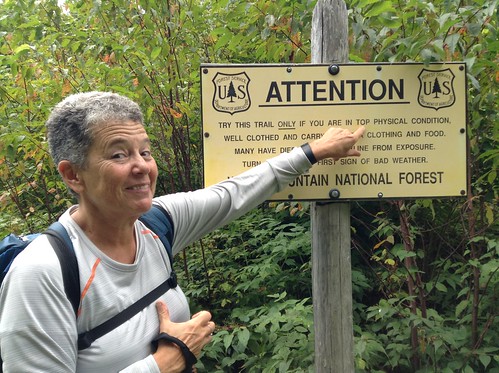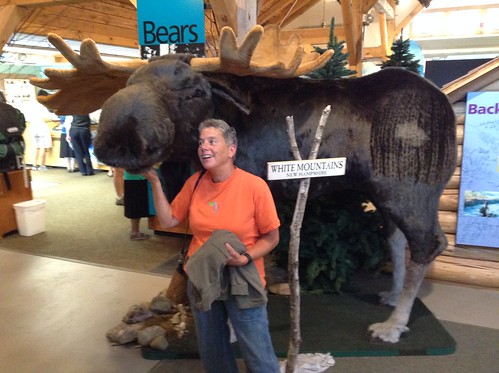
I’ve heard people say they want their ashes spread on Mt. Washington. My mother may have thought she’d unwittingly agreed to the same fate when I took her up New England’s tallest peak for her 60th birthday.
As we reached the summit on Aug. 11, it was freezing with hurricane-force wind. The temperature dropped to 44-degrees F, the rain turned to hail, and the wind ramped up to 71 mph (the highest windspeed all month, according to Mt. Washington Observatory’s weather data). That translates to a wind chill of 30-degrees F.
And that wasn’t even the hardest part of our three-day trek through the White Mountains. Happy Birthday, Mom!
THE SETUP
My mother, Linda, has wanted to climb Mt. Washington for several years, ever since I started exploring the White Mountains in 2013 and began coming home with photos from Mt. Washington, from Tuckerman Ravine, from the Northern Presidentials, from the Presidential Traverse. She’d say: “I’d like to see that someday.”
So really, she asked for this.
I told her we were going on a six-day mystery road trip, which began with three days in the Finger Lakes wine region of central New York. It was Linda’s first time seeing some serious vineyards outside of the quaint wineries of our small home state, Connecticut.
On Aug. 10, we woke at 4am and left the Finger Lakes, driving seven hours across New York, Vermont, and New Hampshire to the town of North Conway. By then, with Mt. Washington looming overhead, Linda knew where we were headed. I told her we’d need to pack food and clothing for three days, and the scale of our hike began to dawn on her.
It’s one thing to go up and down Mt. Washington in one day, an 8.4-mile hike with the assurance of a hot shower, warm meal, and soft bed awaiting you at the end. It’s another thing to spend three days in the wilderness, carrying packs with all food and camping supplies, sleeping on hard surfaces, hiking through the elements, waking to 60-year-old aches and pains.
We stopped at the gear shop IME to buy last-minute supplies and check the weather charts. Thunder storms were forecast for the following day, Aug. 11. A stern, gray-haired man at IME warned us: “Tomorrow is not a day when you want to be above tree-line.” I nodded.
My mother, no doubt intimidated by the burly boots for sale all around her in the store, said to me: “I don’t know if my 12-year-old hiking boots, which I haven’t worn in 12 years, will be okay.” She found a second-hand pair of Asolo hiking shoes from IME’s basement consignment section.
We walked out, got back in the Subaru, and kept driving toward Mt. Washington, anxious but excited.
Linda asked: “Do you think the weather will be a problem?” I shrugged: “On Mt. Washington, the weather can always be a problem. Locals have the luxury to choose what day they want to hike, but we’ve come a long way and we’re here now. We’ll take it as it comes.”
And she said: “I trust you, Stevie, I know that you’ll take care of me.”
Oh boy.
DAY ONE: ANXIETY AND OMINOUS SIGNS
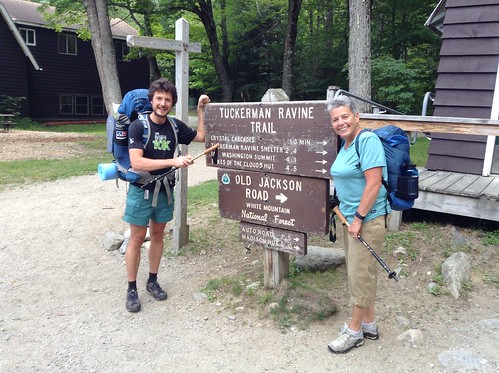 We parked at Pinkham Notch Visitor Center and changed into our hiking gear in the downstairs locker rooms. Upstairs in the lobby, I showed Linda a 6-by-6-foot topographical map of the mountain range, beneath which is listed the 150-odd people known to have died around Mt. Washington since 1849. Her eyes widened and glued to the name of a 63-year-old who died of a heart attack on the Tuckerman Ravine Trail, where we were headed.
We parked at Pinkham Notch Visitor Center and changed into our hiking gear in the downstairs locker rooms. Upstairs in the lobby, I showed Linda a 6-by-6-foot topographical map of the mountain range, beneath which is listed the 150-odd people known to have died around Mt. Washington since 1849. Her eyes widened and glued to the name of a 63-year-old who died of a heart attack on the Tuckerman Ravine Trail, where we were headed.
Linda was visibly anxious to get going. She later likened the feeling to that moment before you board a roller coaster: you’ve invested all that time standing in line, and you could still turn back, but you just want to be strapped in and to have the bail-out option taken away. You may lose your stomach on the ride, but you won’t die… hopefully.
“You know I can do this, right?” she asked me.
“Lots of people do this,” I assured her.
We finished packing. I gently stuffed a full-size bag of Utz potato chips — sour cream and onion, Linda’s favorite — into the exterior pocket of my backpack. We each took a trekking pole and started walking up the Tuckerman Ravine Trail. It was 4:30pm.

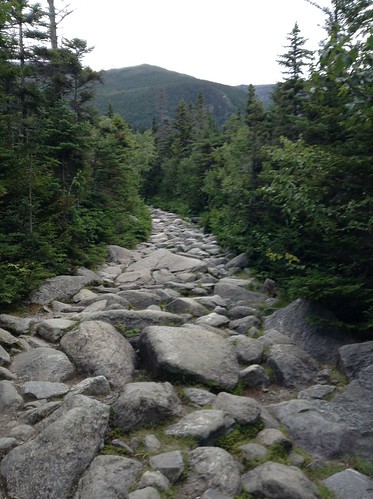
The dirt trail soon turned into a mass of large rocks. Linda didn’t yet realize, but this would be the terrain for the next three days. Mt. Washington and the high peaks of the White Mountains are huge piles of mica schist and granite cobbles, forcing the hiker to pay close attention to the ground and hop from one rock to the next.
Dozens of hikers were coming down from the summit, some limping and asking: “How much further to the road?”
“You’re close,” Linda assured them.
After 2.5 miles, we arrived at the Hermit Lake Shelters, which are just below Tuckerman Ravine. Linda felt good — she’d finished Day One. We checked in with the AMC caretaker, a person who stays at Hermit Lake year-round to collect camping fees, provide weather reports, and respond to emergencies. Then we picked a place to sleep in a three-sided shack close to the bathroom and with a sliding front door that could keep out critters.
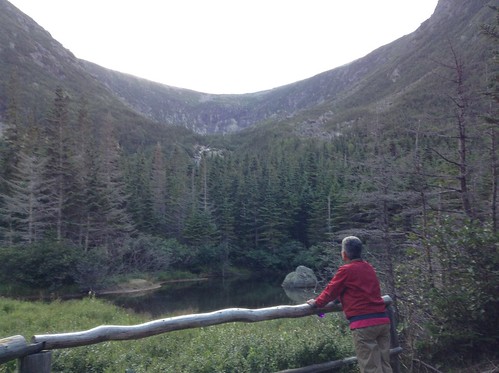
As we dropped our bags, another man popped out of the shelter and welcomed us to Hermit Lake — he said he was living there alone for a full week, a veritable hermit.
Linda gave me a look like: “We’re sharing this shack with somebody else?” She later learned that we were also sharing the space with curious squirrels and at least one bold mouse that fearlessly scurried around our feet as we played a hand of rummy after dinner.
We unpacked our bags and unrolled our sleeping pads and sleeping bags. It was only 6:30pm, so we walked around Hermit Lake and said hello to other hikers setting up camp, including a large group of Canadians. One was hunched over his boots, duct-taping the rubber to the leather. His boots seemed to have fallen apart on the trail after rotting in his closet from years of neglect — this could have been my mother had she not invested in that new pair at IME in North Conway.
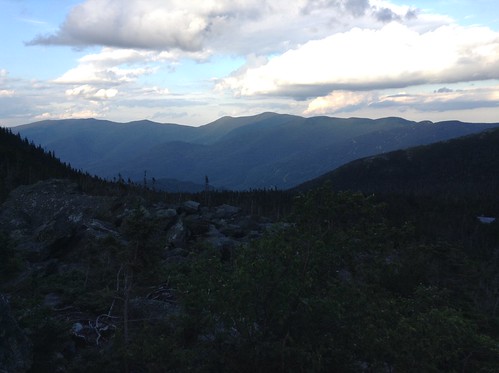
Back at our shelter, we laid out a royal spread for dinner: red wine, fresh olives, sliced avocado, goat cheese from a Finger Lakes farm, premium crackers (not any old Ritz), freshly opened potato chips, and, my stand-by, instant ramen noodles paired with fresh tomato. As dessert we drank tea accompanied by chocolate-covered biscotti. Simple food tastes amazing when camping.
Linda told our neighbor: “This is what I’ve always said I’d want as my last meal: good cheese, olives, wine.” She didn’t realize how ominous she sounded in saying my last meal. It was like Jesus breaking break with his disciples before the crucifixion. Was Linda doing this for herself, or for me?
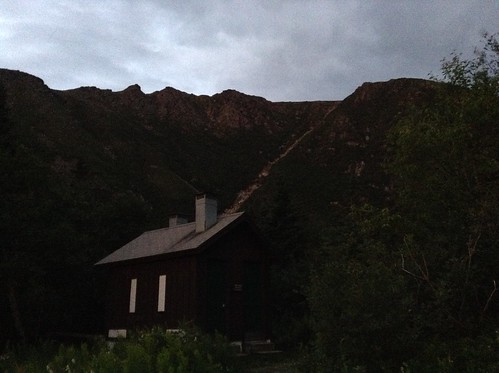
By 9pm, both of us were in our sleeping bags. At 10pm, I heard our neighbor exclaim: “I just saw an amazing shooting star from the Perseid meteor shower! It lit up the whole sky! I caught the whole thing with my camera!” My mother congratulated him, setting down her book for a moment: “That’s just great,” she said. I was already half-asleep. Neither of us felt any inclination to move.
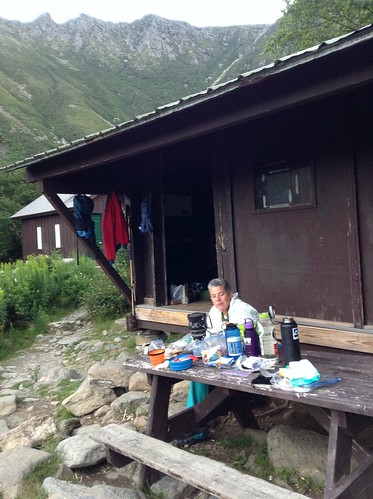
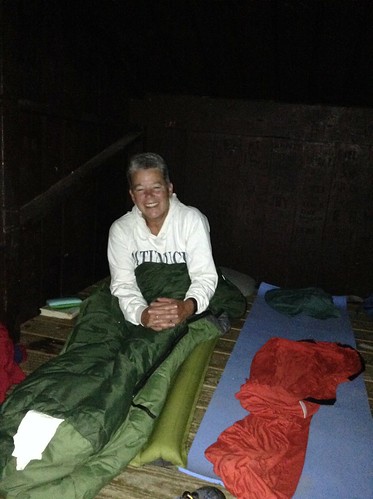
DAY TWO: “The World’s Worst Weather”
We woke at 5:17am to the sunrise as I slid open the shelter’s door. After a round of instant coffee and instant oatmeal, we packed and were back on the Tuckerman Ravine Trail by about 7am.
“This is where I skied last spring,” I told her as we ascended the steep bowl of Tuckerman Ravine.
“Wow,” Linda said. She said that a lot.
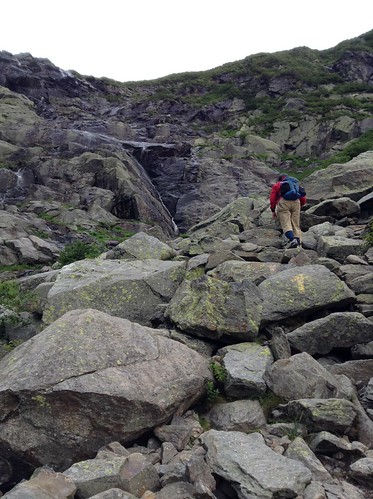
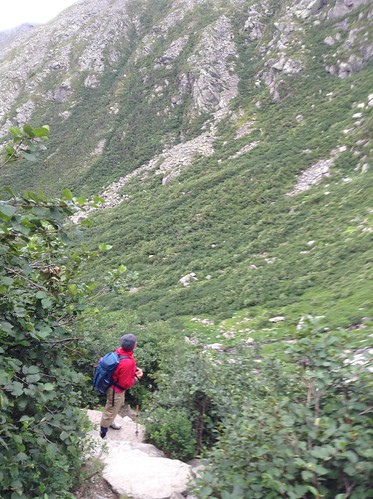

Looking around us, we could see the predicted storm clouds rolling into the valley below us and tumbling over the ridge above us. We were in-between the two layers of clouds.
We topped out of Tuckerman Ravine to within a mile of Mt. Washington’s summit, which was shrouded in thick clouds. Minutes later, the storm clouds enveloped us, too. Visibility dropped to about 25 feet.

Instead of going straight to the summit, I took us across the ridge to the Crawford Path, hoping for a glimpse of the Lakes of the Clouds Hut a half-mile away. Not only was the hut invisible, but we had no visibility on the trail beyond the next cairn.
We heard voices, although we could not see where the voices were coming from. Suddenly I saw a movement on the trail so close that I could toss a rock at it — it was two other hikers headed for the summit.

Now the wind picked up to 71mph. The rain began to freeze into tiny hail stones.
The two hikers in front of us stopped. As we passed them, one was on the ground, blown over by the wind. She was crying and frightened.
Visibility was so low that we had no idea how far it was to the summit until, BOOM, we were standing beneath one of the weather towers. Another strong gust blew me sideways and pushed Linda to the ground. The look on her face was, in a word, unnerved.
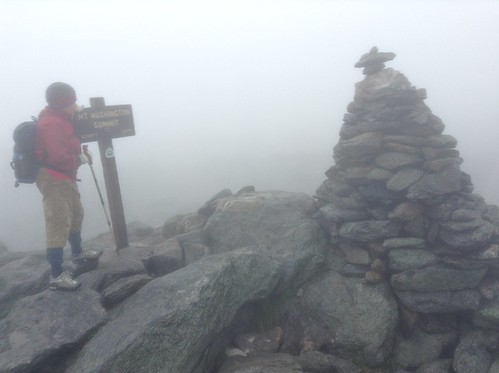
It all offered a sense of why Mt. Washington claims “the world’s worst weather.” The highest wind speed ever recorded by man was atop Mt. Washington in 1934, at 231 mph. The only higher wind speed measured on earth was in 1996, when Tropical Cyclone Olivia sent a 254 mph gust over an Australian island, although that was recorded by a remote device and not two dudes hunkered inside a rattling cabin.
A bit after 9am we reached the summit post, which showed us at elevation 6,288 ft (1,917 m). We were the only people outside, although in summertime the summit is normally overrun with tourists who drove up the Auto Road or rode up the Cog Railway. I snapped a photo of Linda and then we gladly took shelter inside the visitor center. We shed our wet clothes and changed into dry shirts.
We consulted the weather report displayed on a large monitor inside the visitor center. Radar showed a massive storm moving easterly across New England for the next several hours. There seemed nothing to do but wait for it to pass, or to take the shuttle down the Auto Road, which would cost $30 apiece until 4pm, when the price jumped to $50 apiece.
We picked an empty table for ourselves and spread out comfort food: coffee, trail mix, potato chips. We played rummy. I bought several postcards and had Linda write notes to family, which we mailed from the summit’s Post Office. Linda later told me that, as she wrote those postcards, she was thinking: This might be the last thing I ever say to them.
That was our setup for seven hours while the storm raged outside.
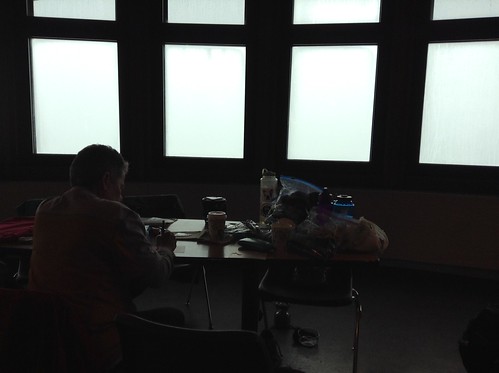
At 11am, a father and son showed up. They’d taken the Cog Railway to the summit and gotten soaked from walking a mere 100 feet into the visitors’ center. “It felt like riding inside a drying machine,” the dad said of riding inside the train carriage.
At 12pm, a teenager showed up alone. Sopping wet and shivering, he said he’d been hiking with his father, but they’d lost each other in the clouds somewhere between Mt. Washington and five miles back at Mt. Madison. The kid would be waiting all afternoon for his father to arrive.
At 1pm, two burly hikers walked into the visitor center. My mother commented: “They look like seasoned hikers, and they’re taking the shuttle down.”
At 2pm, two manly Canadians, dressed to the nines in serious trekking gear and rain protection, departed the summit’s visitor center to hike back down to Pinkham Notch. A half-hour later, they walked back inside, soaked. “What happened?” I asked. One replied: “The weather is too brutal. We’re taking the shuttle down.”
At 3pm, a ranger warned that the shuttle service back to Pinkham Notch was shutting down early because the high winds and pounding rain compromised the safety of the Auto Road, and because so few people were stupid enough to want to be on the mountain.
At 3:30pm, the visitor center began closing down. Staff started mopping floors and stacking chairs. A ranger told us that we had to make a decision soon because “you’re not spending the night here.”
Linda looked at me, and I told her we had five options, none bad: 1) Pay $50 apiece to take the shuttle down the Auto Road; 2) Hike 2.5 miles back to Hermit Lake Shelters for the night; 3) Hike 4.5 miles back to Pinkham Notch; 4) Hike 1 mile to Lakes of the Clouds Hut and potentially pay $127 apiece to stay there overnight; 5) Continue with the original plan of hiking 5.5 miles above tree-line across the high-elevation Presidential ridge, which is totally exposed to the elements and covered in challenging boulder-strewn terrain.
“Stevie, it’s too many details,” she said. “Just tell me what to do.”
The radar showed the storm finally breaking, I said. I pointed out the window and said it seemed we could now see several hundred feet to a parking lot. She was skeptical: “I don’t see any further,” she said. “Look at how the window pane is still shaking in the wind.”
Linda called her husband — a call that she felt she had to make in case he never heard from her again, she later told me. Linda told him that we didn’t want to take the shuttle down, that the cost of $50 apiece was outrageous, and she asked him to pray that her son would make the right decision for what to do.
She hung up and looked at me.
“I think our original plan to hike 5.5 miles across the Presidential ridge is still doable,” I said.
“You really think we can do it, Stevie?”
“Yes.”
Again, it was this dangerous combination of her putting trust in me and me saying, “Let’s go for it!”
We packed and marched into the rain at about 4:15pm. We both wore wool hats, gloves, long shirts, jackets, and ponchos.
“I’m a little nervous,” my 60-year-old mother said.
“We know what to expect, and we have backup options,” I said. “We’ll be fine. It’s a five-mile hike. We’ll be at Gray Knob cabin before sunset.”
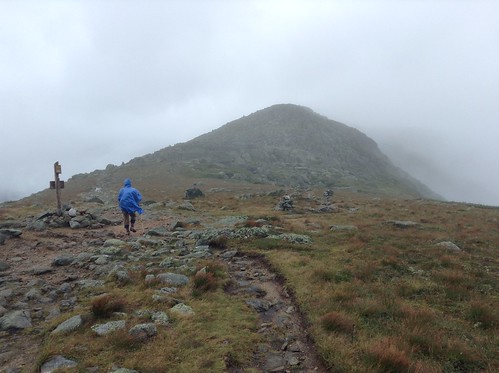
Ten minutes later, Linda broke down crying. She seemed to have suddenly realized that going down would be worse than going up, that the rain had turned the trail into a field of slippery boulders, that the hours of waiting inside the summit visitor center had thoroughly rattled her nerves.
“I don’t know if I can do this,” Linda said.
“Mom, we can still turn back and take the shuttle down, that’s okay, there’s nothing wrong with that. But if we’re going on, you need to be okay with us going on.”
“Just let me cry,” she said. “I just need to let out some stress.”
For the first time I wondered: What kind of birthday gift was I giving to my mother?
The clouds filled her with trepidation: We could sense the precipice but not see it, we could think about the storm but not see it, we could hear the Cog Railway but not see it.
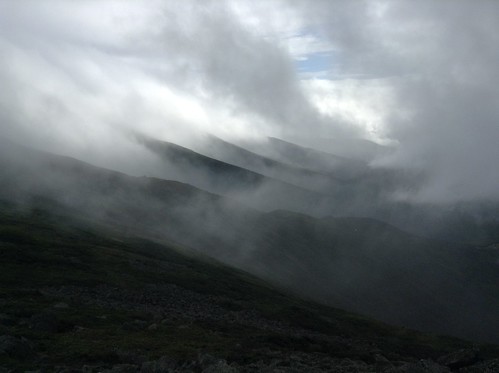
We got down from Washington and began hiking along the ridge toward Mt. Clay. The sky opened up and once again we were in-between layers of thick clouds. For Linda, the view was overshadowed by a fear of the unknown. Where was the trail? Where was the cliff’s edge? Where was the end? For me, aloof to the pain that my mother was increasingly feeling, the view was stunning and totally worth the risk of potentially getting caught in a thunderstorm.
I expected the five-mile hike to take about 3 hours, putting us on the north side of Mt. Adams at Gray Knob cabin before dark. I had not factored the slipperiness of the rocks, the physical exhaustion of my mother, or the mental fatigue she was already feeling from the pressure-filled situation. We moved at about 1 mile per hour.
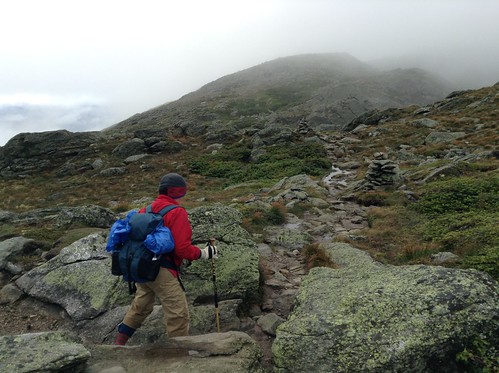
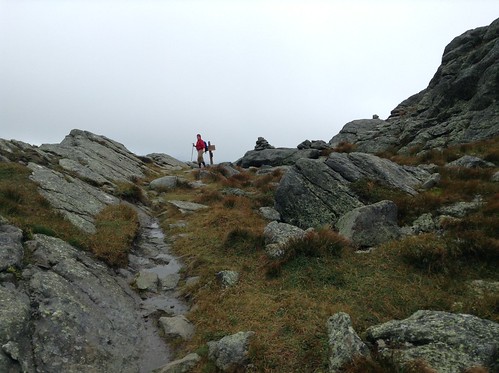
By 8pm, it was obvious that we’d be hiking in the dark. Linda was drained. We’d been up since 5am. Her mind had been imagining worst-case scenarios all day long, and now a worst-case scenario seemed to be unfolding. Linda was wondering if I’d lost the trail, if we’d have to spend the night in the woods, if the ominous thunderstorm would start. I saw lightning in the distance.
I took Linda’s backpack and began holding her hand to help her across the rocky path. She was tripping constantly, at high risk of falling and breaking a tooth or spraining a wrist or ankle. Every step seemed a strain. Each boulder seemed like another Mt. Washington. We both wore headlamps; I also held a flashlight in my mouth.
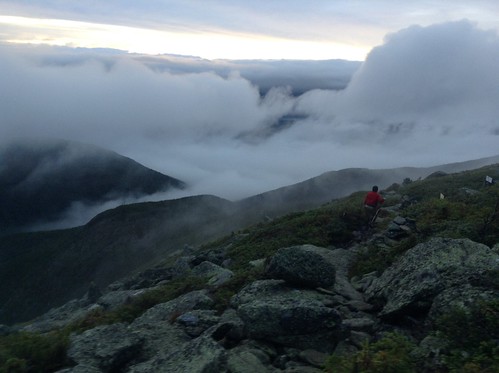
Linda fell. Then I fell. Then she fell again. “I don’t know if I can keep going,” she said, tears coming down her cheeks. “I’m sorry.”
“Don’t be sorry,” I said, hugging her. “I’m sorry that I’ve gotten you into this.”
“How much further?” she asked.
“It shouldn’t be far,” I said. “We’ll stop at Gray Knob, we don’t need to keep hiking the extra half-mile to Crag Camp.”
“But you wanted us to camp there tonight, we can still go,” Linda said meekly — even after all this, she was still trying to be sporting.
“I’ve already put you through enough misery,” I said. “Gray Knob will be good for tonight.”
At exactly 9:17pm — a time that is seared into my mother’s brain, she says — we reached the cabin. Linda stepped inside and collapsed on a bench. I’d never seen her look so unashamedly exhausted and helpless. We walked to the outhouse, only about 25 feet away from the cabin, but far enough for Linda to groan: “I’m about to go right here.”
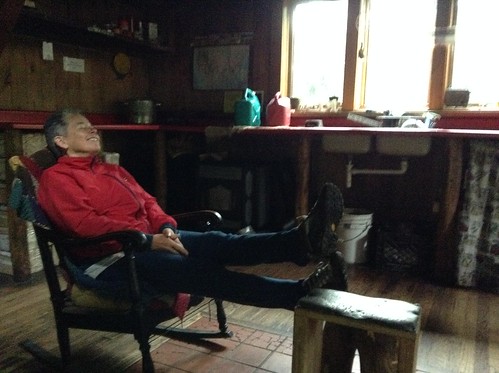
We were all alone in the cabin — nobody else had the gall to hike on such a terrible day — and so I broke etiquette and turned on Linda’s cellphone. She called her husband to say she was safe. He started to cry. She asked about his day, and he started talking about a rental movie he’d seen that night: The In-Laws, starring Alan Arkin. She cut him short: “I’m too tired to talk for long. Can you just call Bonnie (her best friend) and the girls (her daughters) and tell them that I’m safe and we made it?”
By now I’d set up dinner, another spread of Linda’s last meal: wine, cheese, olives, chips. But Linda couldn’t eat a thing. It crossed my mind that I should have ended our road trip in the Finger Lakes, where the wine would have taken the edge off a long and brutal hike and we could have finished on a more happy note.
At 11pm, we got into our sleeping bags. “Stevie, tomorrow I’m going to feel better,” Linda said.
“We still have to hike four miles to get down to the road,” I said.
“I’ll be fine,” she said. And then Linda slept more soundly than she’d slept in months.
DAY THREE: WHAT DOESN’T KILL YOU
I woke at about 6am. From the cabin’s kitchen area, I grabbed two water jugs and walked a quarter-mile to the spring, filled them, and returned to Gray Knob to boil water for our coffee and oatmeal. Linda was by then awake, moving slowly but moving nonetheless. She was indeed feeling better.
It had poured overnight, but the clouds were lifting and the sun was breaking through the trees. By 8am we were on the trail.

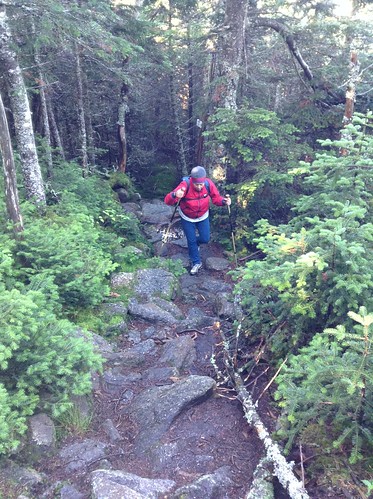 Linda’s quads were shot, so she was using both trekking poles to steady her wobbly legs. We hiked a half-mile to Crag Camp, which overlooks King Ravine. The sky was blue and we could see miles away to the summit of Mt. Madison. The spectacular view seemed to perk up Linda and refill her body much more than any food or coffee.
Linda’s quads were shot, so she was using both trekking poles to steady her wobbly legs. We hiked a half-mile to Crag Camp, which overlooks King Ravine. The sky was blue and we could see miles away to the summit of Mt. Madison. The spectacular view seemed to perk up Linda and refill her body much more than any food or coffee.
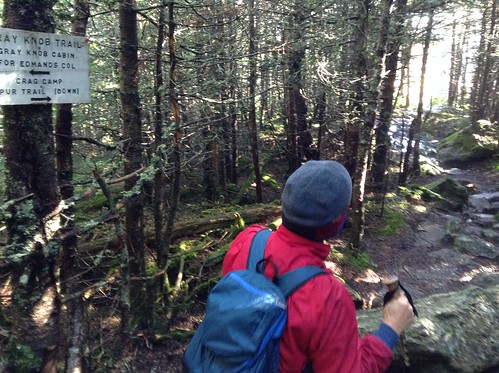
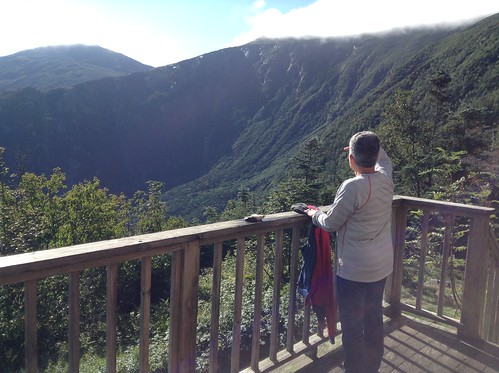
We chatted for an hour with the hut’s young caretaker and a father-daughter pair of hikers who had stayed there overnight. Their jovial dog jumped in the sun. A finch flew onto the deck railing and chirped for food. Inside the cabin, I pointed out the old pump organ that was hauled up piecemeal in the 1960s and lovingly reassembled inside the cabin.
The setting was almost surreal, like we’d emerged into a kind of mountain-top Eden.
From Crag Camp, it was about four miles down to Rt. 2, a hike that took us about 3 hours.
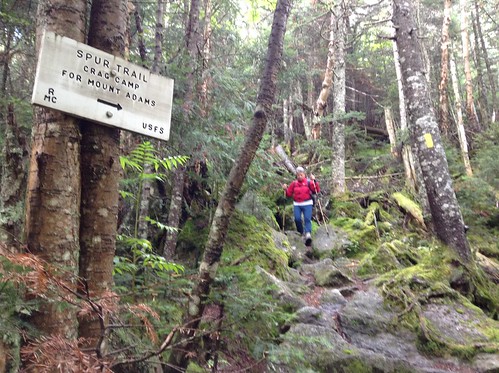
The forest changed from rocky ground with stubby evergreens to mushroom-lined dirt trail surrounded by tall maples. The air warmed and the humidity increased. It was almost balmy.
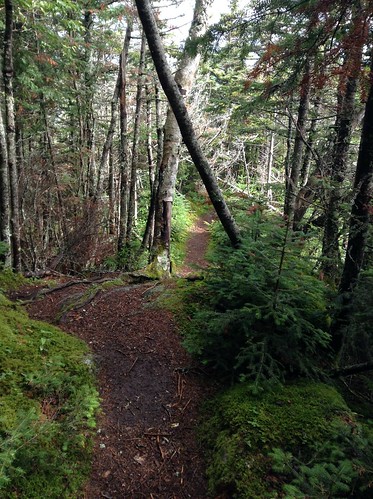
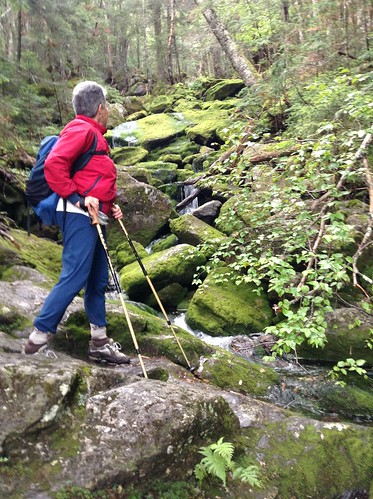
At 12:30pm we reached Appalachia Trailhead on Rt. 2, where my mother started to cry again.
“I’m so sad that it’s over,” she sniffled. She seemed like a kid on the day after Christmas, half-stunned by all the presents and incredulous that something so overwhelming was suddenly all over.
Relieved that that we’d made it off the mountain without injury, I joked, “It’s not a Stevie-Kurczy-Hike unless somebody cries.” We changed into sandals.
Linda experienced the extremes of Washington and the White Mountains — kind people, strange people, intimidating outdoorsmen, inviting weather, scary weather, erratic climate, sweeping views, no visibility, stunning vistas. I think she could now understand why some people would want to leave their ashes up there.
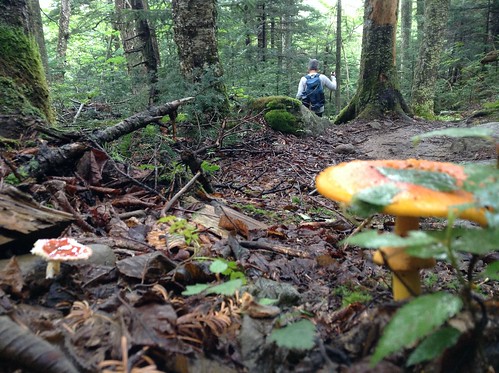
We stood at the roadside and stuck out our thumbs: within five minutes, a Subaru stopped and offered us a lift all the way back to our car at Pinkham Notch, 17 miles away. Speaking to the driver, my mother gushed about how her son had just taken her on an amazing three-day trek through the White Mountains.
“When my mother turned 80, I took her on a road trip to Washington, D.C.,” the driver responded. “She was so happy we did it. And so was I, because she died two years later.”
I don’t think he realized how morose that sounded! “Hopefully my mother lasts a few more years,” I joked. Linda laughed.
Back at our car, Linda was finally ready to enjoy the last remnants of her favorite meal: we munched on olives and cheese and washed it down with the final dregs of boxed red wine. It wasn’t Finger Lakes-quality wine, but we were both glad for it nonetheless.
Days later, when I told my editor at The Christian Science Monitor about the trip, he responded: “I think Mt. Washington is supposed to have America’s worst weather. Never been. For her 65th birthday, may I suggest a Death Valley backpacking expedition?”
Now there’s an idea…
